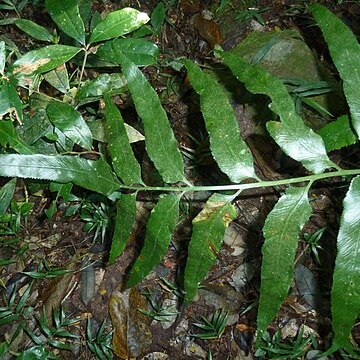Plants terrestrial or epilithic. Rhizome short, erect, to 30 mm long, to 10 mm in diameter, set with roots, crowded persistent stipe bases and scales, scales chartaceous, dull brown, clathrate, sessile, oblong-cuneate, cordate to cordate-imbricate, margins regularly set with short and long filiform outgrowths terminating in an enlarged obovate thin-walled cell, usually with a few glandular cells near the point of attachment, apex terminates in an enlarged obovate thin-walled cell, to 13 mm long, to 1.5 mm wide. Fronds crowded, caespitose, suberect to arching, to 740 mm long; stipe firm, castaneous, adaxially sulcate, to 200 mm long, to 4 mm in diameter, initially closely scaled, scales chartaceous, dark brown, clathrate, sessile, linear to filiform, cordate to cordate-imbricate, margins regularly set with short and long filiform outgrowths terminating in an enlarged obovate thin-walled cell, to 5 mm long, to 0.2 mm wide; lamina anadromous, 1-pinnate, elliptic, to 530 mm long, to 280 mm wide, with up to 14 petiolated pinna pairs; rachis firm, adaxially sulcate, green, brown abaxially, sparsely set with scales similar to those on the stipe; pinnae petiolate, petiole to 2 mm long, opposite to alternate, basally more widely spaced than apically, the 2 or 3 basal pairs generally gradually reduced, firmly herbaceous, inequilaterally oblong-cuneate to narrowly lanceolate, acroscopically truncate to broadly cuneate, basiscopically narrowly cuneate, dentate, to 150 mm long, to 25 mm wide, adaxially glabrous, abaxially with scattered scales along the costa and veins, scales chartaceous, castaneous, sessile, filiform, with short filiform outgrowths and enlarged thin-walled cells at the point of attachment, apex terminates in an enlarged oblong thin-walled cell, to 1.5 mm long, to 0.4 mm wide; costa adaxially raised, convex. Venation evident, pinnately branched, branches forked, ending in the teeth near the margin. Sori linear, inframedial, extending along a vein, to 4 mm long; indusium firmly herbaceous, stramineous, linear, entire, attached along the entire length, to 4 mm long, to 0.3 m wide; sporangium long-stalked, uniseriate, 3-seriate below the capsule, capsule globose to broadly elliptic in lateral view, annulus with (16-)18(-19) indurated annulus cells, epistomium (2-)3-celled, hypostomium (3-)4-celled. Spores 64 per sporangium, brown, broadly elliptic, monolete, perispore forms broad reticulate wings, exospore (34-)35.5(-38) x (24-)26.8(-30) µm.
More
Rhizome erect, c. 10-20 mm in diameter, set with pale brown to brown, concolorous, broadly lanceolate, somewhat fimbriate and attenuate rhizome-scales c. 12 x 3.5 mm. Fronds tufted, herbaceous, not gemmiferous; stipe matt purplish brown, glabrous except for scales basally; lamina ovate to ovate-elliptic, up to 880 x 320 mm, pinnate, basal pinnae somewhat reduced; pinnae in 10-20 pairs, up to 220 x 24 mm, base unequally cuneate, margin regularly crenate-dentate, upper surface glabrous, lower surface set with scattered, minute, sub-stellate scales on costae and veins. Sori extending along veins from near costa half-way to margin, 4-6 mm long at maturity; indusium membranous, yellowish, entire, c. 1 mm broad.
Rhizome erect, up to 10 mm in diam., with crowded stipe bases and pale brown, lanceolate scales, up to 12 x 2.5 mm, fimbriate. Fronds caespitose, erect to arching, up to 450 mm long. Stipe firm, brown, up to 480 mm long, sulcate with a central ridge adaxially. Lamina 1-pinnate, elliptic to oblanceolate, or lanceolate, up to 800 x 300 mm, with 10-20 pinna pairs, non-proliferous. Pinnae narrowly lanceolate, attenuate, somewhat falcate, crenate to serrate, glabrous adaxially, sparsely scaled along costa and veins abaxially. Sori linear, up to 5 mm long. Indusium entire, up to 1 mm wide.
Rhizome erect, set with pale brown to brown rhizome scales. Pinnae with margins bluntly serrate, base unequally cuneate, up to 220 x 24 mm. Sori borne along outermost branch vein of a fork, all of similar lengths.

